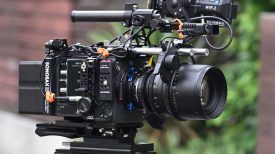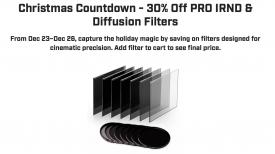By Newsshooter contributor Adrian Storey:
It was a few months after Japan’s March 2011 earthquake, tsunami and the nuclear disaster that followed in Fukushima that I started noticing the stickers of a little girl in a raincoat, scattered around the Shibuya district of Tokyo, bearing the legend “I hate ☢ rain”. I started to photograph and video them.
The months following that disaster were strange. All the lights that had been off or dimmed went back on and life in Tokyo seemed to return to normal – it was as if nothing had happened, or was continuing to happen, just a few hundred kilometres north. For me it felt like the destroyed Fukushima Daiichi nuclear power plant seemed to be always lurking, just out beyond my peripheral vision. The daily ritual of checking every item I bought in the supermarket for its origin had become second nature, but it seemed as if the vast majority of the Japanese public had just hit the reset button and were carrying on exactly as they had before.
It was during all this that the “I hate ☢ rain” stickers really caught my attention. I had no idea if they were being put up by a Japanese or a foreign street artist. They intrigued me and gave me a sense that someone else out there also continued to feel uneasy about the behaviour of the government and power company surrounding what was very clearly a serious situation. ”Keep calm and carry on” just wasn’t working for me, and clearly not for whoever was putting up the stickers.
I continued to film and photograph the stickers for about a year, and made some attempts to find out who the artist was – but to no avail.
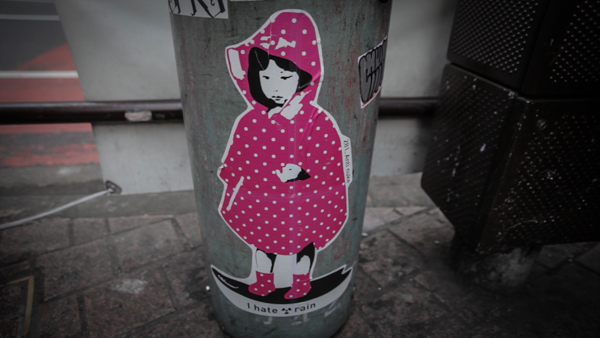
For the first anniversary of the disaster I put together a minute-long piece, using footage of the stickers that I had shot in a bid to make a statement about the ongoing situation. Shortly after posting it on my website I received an email and some tweets from someone claiming to be “281_Anti nuke”, the artist responsible for the work. He wanted to know if he could post the video on his website. Of course I was happy for him to do so – but on one condition: that he allow me to interview him for a documentary about him and his work.
I had no idea whether I would be able to get funding to make the piece, or sell it once it was finished, but this felt important. Often, some of the most rewarding filmmaking for me is personal work. These are pieces I do just because I love the subject, with no time constraints and the freedom to create something I care about deeply.
Street art and graffiti have been a passion of mine since I was a teenager. I may, or may not, have dabbled in street art myself, depending on who is asking. Although a little reticent at first, 281 agreed to let me make a film about him … then disappeared. His website went down and his Twitter feed disappeared. He basically vanished.
The stickers were still appearing around Shibuya; constantly changing designs of the little girl and slowly some additional designs criticizing Tepco (Tokyo Electric Power Co., the utility that operated the Daiichi plant). I knew he was still around, but how to contact him? I had become a little obsessed with meeting whoever was doing this and finding out who they were and why they were doing it. I continued to search out and film his stickers using my trusty Canon 5D mkII (Magic Lantern hacked), which I carried with me wherever I went.
I had to wait a few months until suddenly one day the Twitter feed popped back up, and after a few direct messages, 281 agreed to meet me to discuss the documentary. I was a little surprised when he told me to contact his manager to arrange it, but went ahead.
A week or two later, myself and my translator/producer Erina Suto were sitting across a table in a cafe from manager Ryan Roth and 281, a nervous looking guy in a black hooded top, dark glasses and a face mask. Many months would pass before I saw him dressed in any other way and even now I have only seen his face briefly on a few occasions. Understandably, given the illegal and inflammatory nature of what he was doing, he wanted to check me out as much as I did him. The meeting seemed to go well, and despite not being able to tell him what would ultimately happen with the film, he agreed to be interviewed and let me shoot footage of him on the street.
Over the next couple of months, 281 and I met several times and I would witness him stickering around Shibuya. I was worried that filming him while he was doing his thing might cause unnecessary attention. I kept my setup very minimal: a 5D mkII with Sigma 20mm 1.8 or Canon 50mm f1.4 on a monopod – manoeuvrable, unobtrusive and stable. Sometimes I used a cheap LCD loupe I had bought off eBay to add extra stability, particularly with the 50mm. We also filmed an interview, I believe his first, at a secret location. The room was bland enough to be impossible to identify.
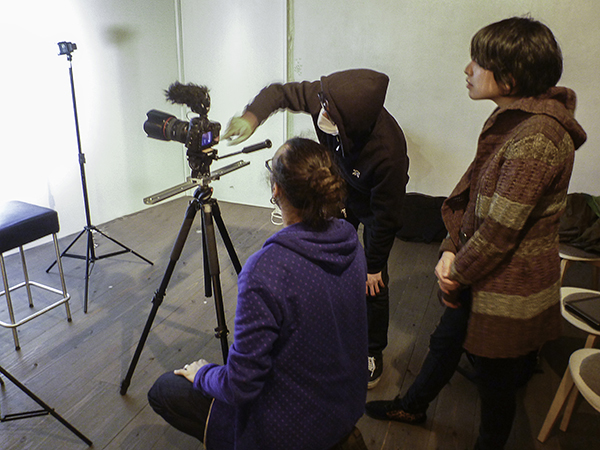
It turned out that the reason his website and Twitter feed had gone down was due to online ultra rightists in Japan attempting to find out who he was. Several very unpleasant threats and comments had been made to him. Keeping his identity secret was important to protect his physical safety.
The interview was shot on the 5D mkII with a Canon 24-70mm lens. I used 2 LED lights: One on him to give the hard shadowed look I wanted, and one on the background to give some separation. I recorded the sound with an Audio Technica lav mic running into a Zoom H1 audio recorder. In a more relaxed interview a few weeks later, in a different location, 281 showed me his laptop to illustrate how he designs the stickers. Further footage showed him cutting each individual sticker by hand.
The second interview was again filmed with the 5D mkII, this time on a Wieldy Carbon fiber stabilizer to give a more fluid movement to the shots. I also used a 60cm long slider to give higher production values that complemented the street shots.The piece was edited in Adobe Premiere Pro CS 5.5. Dual system audio was synced manually from the Zoom.
A lot of the early sticker footage I had collected over the year or so I shot was a little shaky – because much of it was shot on the fly, heading home after a few beverages. I knew new stickers wouldn’t last long so I had to shoot as soon as I saw them appear – handheld on the 5D. This footage was stabilized in post-production using the remarkable warp stabilizer in Adobe After Effects.
Most music used in the film was sourced from musician friends in Tokyo with whom I have ongoing relationships. They supplied tracks in exchange for help with music videos or website assistance.The exception was the track used for the opening and closing sequences by a band from Kyoto called Frying Dutchman. I wanted something unique and powerful to compliment 281’s work. A few months before I had seen “Frying Dutchman” play at an anti nuclear march in Tokyo’s Yoyogi park and a friend had put me on to an epic 20 minute song of theirs called “Human error”. The song was perfect. After a frustrating few weeks of trying to contact them via their website, I managed to get in touch with them via contacts in Kyoto. We met in Tokyo, and after a few drinks and a showing of the rough cut of the film, they agreed to sign a release for the music.
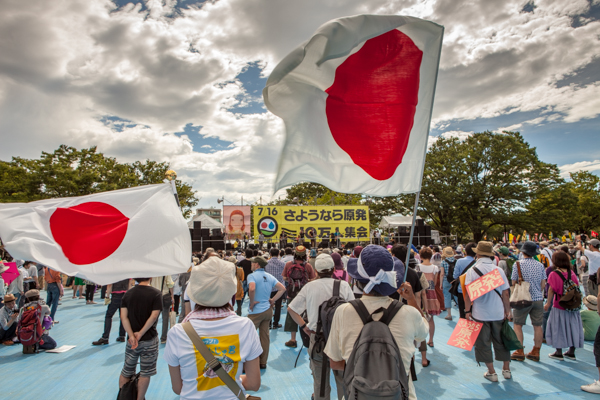
Erina and I rushed to edit a version of the film to make film festival deadlines, and in the haste, produced something that we were unhappy with. It felt rushed and incomplete.
Paid work took a lot of my time away, and I was forced to shelve the film for several months. During this period, 281 began to get significant foreign press attention. Articles appeared in The New Yorker, The Japan Times, on Giant Robot’s website and in other places. Significantly, several articles mentioned the original short documentary I had made and linked to the trailer.
A lull in my other duties allowed me to return to work on the film. With the help of some respected friends, I put together a new edit that I was much happier with. Add in a little colour grading in Adobe Premiere Pro (mainly using fast colour corrector and the free Power Mask plugin), some Audio sparkle from Adobe Audition, and we arrived at what I considered to be the finished film. The question now was how to release it. It felt too important to just stick on Vimeo, I wanted a wider audience for it. I felt like 281 deserved it.
It was then that I went to VICE Japan, for whom I had made another documentary. They had previously turned down the original 281 film. Upon seeing my cut, and having noticed the media attention, VICE said they were interested given a few provisos: They wanted interviews with his manager Ryan Roth; the writer of the New Yorker piece Roland Kelts; and a “graffiti” expert to round out and further legitimize the film.
My previous film for VICE Japan.
With the help of my friend Sean Bonner, I managed to secure an interview with the influential LA based graffiti artist Saber, who is perhaps most famous for the large piece he did on the bank of the Los Angeles river in 1997. The final work, measuring 250×55 feet (76×17 meters) has been called the largest graffiti painting ever. It was even visible from satellites.
I needed to hire a cameraman in LA to film the Saber footage. After reaching out on Twitter, a retweet from my friend and Newsshooter site editor Dan Chung secured someone to do it in 20 minutes! (Big thanks also to Jon Putek, who also supplied some LA b-roll at no additional cost). A similar situation arose with the Ryan Roth’s interview in Hong Kong. A colleague, Newsshooter contributor Jonas Schoenstein, happened to be in Hong Kong and was able to record the interview.
It was the first time for me to pay other shooters to help me finish a documentary. A quick additional interview with Roland Kelts in Tokyo filmed by me on my recently acquired Canon C100 (a dream camera after working with the 5D for so long), and all the footage was ready.
I handed over my original edit of the film to VICE as an Adobe Premiere Pro file. All the additional footage was also given to VICE, who wanted to do their own edit of the piece. I agreed to pass on the editing, but it was a difficult decision. I had spent so much time on the film and felt so close to it. Thankfully, I was allowed a lot of input during the editing stages at VICE as the director.
Respect to Akira Kamitaki, who edited the final version you see here. Thanks also to Sebastian Stein (Vice Japan Production Manager) and Eiji Iwakawa (Vice Japan Post Production Supervisor) for their work on the film too. That said it was painful for my ego to see a producer and editor chop sections out of my film and reduce the length down to a VICE-friendly fifteen or so minutes. I kept reminding myself that by handing the film over to them, I was ensuring a much wider audience. And was at least going to make some money for all the time and effort I had put in it. Akira retained a great deal of my original edit, adding extra footage and adapting the piece to suit VICE’s in-house style.
The short is finally – 2 years later – seeing the light of day. 281 gains increasing exposure, more articles and short video slots are appearing about him, and this piece allows him to speak at greater length about his work and motivations. I would like as many people as possible to see his work and think about what he has to say.
To me, this shy, middle-aged Japanese guy has become something of a hero. I hope his work continues to make people in Japan question what their government and corporations are doing (or not doing) in their names.
He is one of the good guys.
Adrian Storey a.k.a. Uchujin – made in England in 1972. He has led an eclectic life, travelled extensively and has lived in Asia for the past 15 years. He is currently based in Tokyo, where he works as a filmmaker, camera owner/operator, editor and freelance photographer. Work ranges from documentary to music video. Adrian has worked for numerous international clients including Greenpeace, VICE Japan, The Guardian & The Sun.




